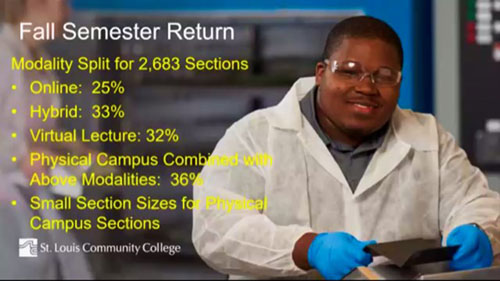
By The Scene staff
As Forest Park students prepare for out-of-the-ordinary ways to learn this fall, St. Louis Community College Chancellor Jeff Pittman says that up to 36% of the college’s 2,683 classes will have at least some face-to-face instruction.
“That doesn’t mean they’ll be fully on campus for the entire time, but we’re starting out and trying to have some interaction with students initially and see how that goes,” he said during a 28-minute “virtual town hall meeting” via Zoom on Aug. 14, 10 days before the start of fall semester.
Pittman said on-campus classes will be small in size as a way to discourage spread of the coronavirus and provide a safe learning experience.
He also announced that the college has streamlined its enrollment process; that games for fall athletic teams will move to spring; that a robust STLCC marketing effort is paying dividends; and that because of enrollment gains, a $1.5 million budget gap may be closed.
Pittman urged students to familiarize themselves with the four instructional methods described on the Modality page of the college’s website, stlcc.edu: face-to-face, live-virtual lecture, online and hybrid. He asked faculty and staff to be vigilant in completing a daily health-screening form before they report to campus while following other pandemic guidelines, including social distancing and hand-washing.

“Be very smart about being around crowds,” he said, citing a Centers for Disease Control recommendation. “Where this infection spreads the most is when large groups of people assemble together in close spaces. And the research is showing that’s where most people catch the disease.”
In preparing for STLCC’s new instructional system, Pittman said college leaders in effect have put all classes in “three buckets” — a majority of liberal arts classes will provide online and live-virtual lectures; and both science and art and career technical programs will offer online, live-virtual lecture and face-to-face classes.
Pittman said the registrar’s tally shows that about a quarter of classes will be online only and one-third are classified as hybrid (live-virtual lecture/online/on-campus).
The college is simplifying its enrollment process, helping to improve delivery of pertinent information to students. A streamlined student orientation for fall will be entirely online, and a new app will allow enrollment and registration by smartphone.
Pittman praised three college marketing campaigns now in place: “Come as you are, see what you become,” which was launched last year; “Take one on us,” which advertises the fact that students can take one free class this summer and fall; and a “stay local” pitch to university students who may not want to live in dorms this semester due to COVID-19. They can pick up transferable classes at STLCC.
“Universities will probably offer a lot of their classes online too, so, as you know, we offer a much better value with our tuition and the high quality of instruction that we offer,” Pittman said.
The college is using multiple social-media platforms to get its message out. Pittman said success is indicated by a 20% increase in enrollment traffic on the college website; a 36%
increase in general page views; and a 5% increase in first-page Google search results compared to last year.
An STLCC budget passed this summer left a $1.5 million gap, but Pittman said: “I understand that because our enrollment was up in the summer and the way that it’s trending right now that the $1.5 million gap may be wiped out and be back to even. … This just shows the nature of how important our enrollment is and the maintenance fees are to the college and how that helps with the budget.”
The $15 million the college received in federal CARES Act grant money can be used only for reimbursements, earmarked for student aid, scholarships, laptops and coronavirus-related expenses.
With state revenue lagging, Pittman said the college is likely to see further withholding of funds this fiscal year. The STLCC budget-response team, in its long-term planning, has offered the following recommendations, which have not yet been approved:
- Implement additional furloughs (the leadership team is now furloughing one day a month)
- Reduce expenses by simplifying software contracts
- Trim employee benefits
- Become more efficient in scheduling to reduce costs in instruction
- Offer another voluntary separation program or early retirement option
- Combine positions when individuals leave the college or retire
- Outsource jobs
- Provide flexible work hours and work-from-home options
- Go completely paperless
- Reduce travel
Pittman also said:
- The men’s and women’s soccer teams and the women’s volleyball team will be allowed to practice and scrimmage this fall but must wait until spring to face live action, according to National Junior College Athletic Association guidelines announced in July.
- College representatives have continued to participate since April in bargaining talks with the Service Employees International Union, which represents part-time faculty members.
- In the event of a worsening COVID-19 crisis, the campus could be closed while moving as many classes as possible to online-only instruction.
The college is trying to expand internet access for students who can’t afford Wi-Fi at home.
